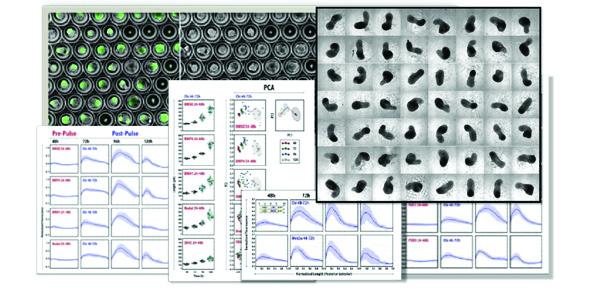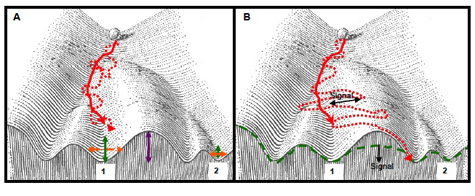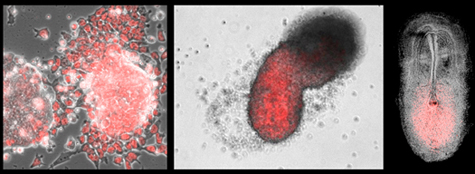
Laboratory of the Structure and Function of Living Matter
Keywords
Cell fate decisions, Signal transduction, Embryonic Stem cells, Self organisation, Physics of Biology, Imaging
Research interests
We envision biological systems as Living Matter because we are interested in looking at the way in which its fundamental components (genes and proteins) organise themselves in a manner that creates and processes information. A product of this organisation is cells, which are the units from which tissues and organs emerge. We are interested in describing and understanding the molecular networks that emerge from the interactions between genes and proteins that enable cells to interact with each other, make decisions about their fates (phenotypes) and self organise in space and time.
A common representation of this process is Waddington’s epigenetic landscape [see Figure below] which portrays trajectories of cells during development towards specific fates, which are thought of as attractors of dynamical systems built by interactions between signal and transcription factor networks.

Our main experimental system at the moment is mouse Embryonic Stem (ES) cells that we see as the basis for an interdisciplinary approach to how cells generate organs and tissues, with a combination of classical genetics, quantitative cell biology, image analysis and modelling. A few years ago we observed that, under controlled experimental conditions, mouse ES cells can be coaxed into forming patterned aggregates that mimic many of the events of early embryogenesis including gastrulation and axial organisation. We called these entities "gastruloids" and, for the last few years, have been using them to explore a number of novel research avenues about how cells form tissues and organs, that cannot be explored with embryos. The picture below shows ES cells bearing a reporter for Wnt signalling in a differentiating colony (left), a gastruloid (centre, showing the polarised organisation of the signalling event) and in an embryo at the end of gastrulation.

We have close interactions with Ben Steventon's Group.
If you have an interest in the engineering of embryos, or computational aspects of developmental biology, get in touch!
Currently we have four related lines of work:
- Stochastic and deterministic processes in cell fate decisions
- Genetically supervised ‘self-organisation’ of ensembles of ES cells
- The development of gastruloid technology to human cells
- Integration of transcriptional and mechanical networks during early mammalian development
In the news
Group members have recently featured in news items related to their gastruloid research published in 'Nature' in October 2018 [Item #1 in 'Recent publiations' below]:
- Mouse Stem Cells Made to Form Embryo-Like Structures [The Scientist]
- Self-organising ‘gastruloids’ mimic early development of mouse embryos [NC3Rs]
- Scientists develop mouse ‘embryo-like structures’ with organisation along body’s major axes [University of Cambridge]
- 'Artificial embryos' may reduce the need for animals in research [BBSRC]
For further details visit our website and follow us on Twitter: ™MartinezArias
Recent publications
- Beccari, L., Moris, N., Girgin, M., Turner, D., Baillie-Johnson, P., Cossy, A.C., Lutolf, M., Duboule, D. and Martinez Arias, A. (2018) Multiaxial self organization properties of mouse embryonic stem cells gastruloids. Nature 562, 272-276.
- Martinez Arias, A. and Steventon B. (2018) On the nature and function of organizers. Development 145: dev159525 doi: 10.1242/dev.159525
- Moris, N. and Martinez Arias, A. (2017) The hidden memory of differentiating cells. Cell Syst. 27, 163-164
- Turner, D.A., Girgin, M., Alonso-Crisostomo, L., Trivedi, V., Baillie-Johnson, P., Glodowski, C.R., Hayward, P.C., Collignon, J., Gustavsen, C., Serup, P., Steventon, B., Lutolf, M. and Martinez Arias A. (2017) Anteroposterior polarity and elongation in the absence of extra-embryonic tissues and of spatially localised signalling in gastruloids: mammalian embryonic organoids. Development 144, 3894-3906
- Schroeter, C., Rue, P. MacKenzie, J. and Martinez Arias, A. (2015) FGF/MAPK signaling sets the switching threshold of a bistable circuit controlling cell fate decisions in ES cells Development 142, 4205-4216
- van den Brink,, S., Baillie-Johnson, P., Balayo, T., Hadjantonakis, A.K., Nowotschin, S., Turner, D.A. And & Martinez Arias, A. (2014) Symmetry breaking, germ layer specification and axial organisation in aggregates of mouse ES cells. Development 141, 4231-4242
- Turner, DT., Hayward, P., Baillie-Johnson, P., Broome, R., Rue, P., Faunes, F. and Martinez Arias, A. (2014) Wnt/ß-catenin and FGF signalling direct the specification and maintenance of a neuromesodermal axial progenitor in ensembles of mouse ES cells. Development 141, 4242-4253.
- Turner, DT., Trott, J., Hayward, P., Rue, P. and Martinez Arias, A. (2014) An interplay between extracellular signalling and the dynamics of the exit from pluripotency drives cell fate decisions in mouse ES cells. Biology Open 3, 614-626
- Turner, DT., MacKenzie, J., Davies, E. and Martinez Arias, A. (2013) Brachyury cooperates with Wnt/ß-Catenin signalling to specify individual cell velocities during Primitive Streak differentiation of mouse ES cells. BMC Biology 13, 63 doi:10.1186/s12915-014-0063-7
- Muñoz Descalzo, S., de Navascues, J. and Martinez Arias, A. (2012) Wnt/Noch signaling: an integrated mechanism regulating transitions between cell states. Bioessays 34, 110-118
>> Full list of publications on PubMed
Page updated 26 Nov 2018
